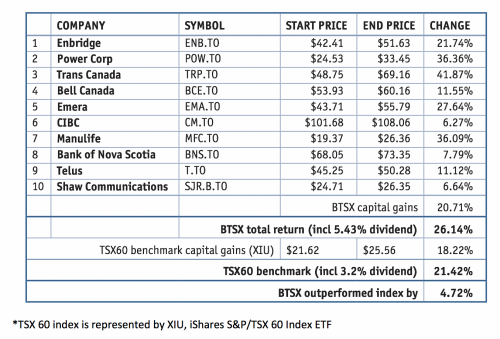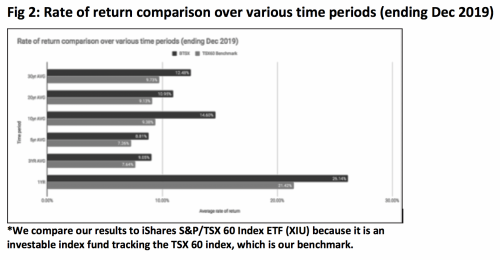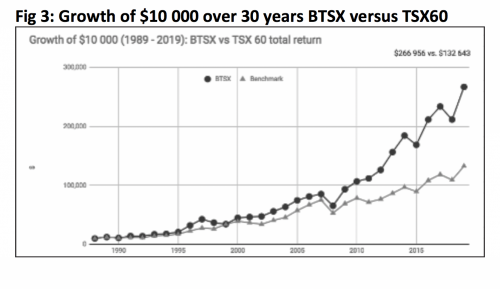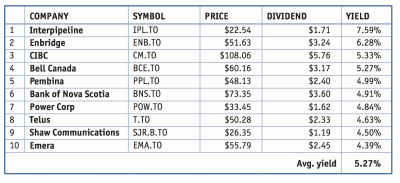Beating The TSX 2020: Higher Returns And Rising Dividends
 When I sat down to write my first Beating the TSX article for the Canadian MoneySaver at this time last year I thought our decade-long bull market might be coming to an end. The index had dropped about 20% by mid-December and, perhaps worse, it was one of the rare years that BTSX had under-performed. The first sentence of that article was: “If there is one thing the stock market can be counted on to do, it’s this: it will test you.”
When I sat down to write my first Beating the TSX article for the Canadian MoneySaver at this time last year I thought our decade-long bull market might be coming to an end. The index had dropped about 20% by mid-December and, perhaps worse, it was one of the rare years that BTSX had under-performed. The first sentence of that article was: “If there is one thing the stock market can be counted on to do, it’s this: it will test you.”
If you stuck with an investment plan based on the Beating the TSX strategy, however, you would have passed that test. The bear market predictions were wrong again. In 2019 our BTSX stocks boasted a total return of 26.14%, beating the TSX60 index which rose by 21.42% - a 4.72% difference.
Figure 1: Performance of BTSX vs TSX60 in 2019

As you can see from the preceding figure, not a single BTSX stock lost value in 2019. In fact, three of our stocks had price increases over 30%. Not many were predicting such a good year for investors and BTSX did especially well.
Another Year Of Rising Dividends
What is equally remarkable, however, is that eight of the ten stocks increased their dividends in 2019 - only MFC and SJR.B did not. We only use the starting dividend yield to calculate our results, but in reality our dividend payments increased by an additional 5.23% in 2019. Incidentally, this means our historical performance is almost always a little better than reported.
A five percent dividend increase is in line with what BTSX investors have come to expect from the strategy (it was 4.8% last year). Many overlook the importance of such increases, but they are a key benefit for investors. A high but sustainable dividend yield is important - and we select for that - but it is the rising dividends that buffer investors from inflation and allow them to sustain their standard of living - the perfect scenario.
BTSX Continues To Beat The Index
Regarding total returns, the 4.7% percent advantage over the index that we enjoyed in 2019 is nice, but the true strength of Beating the TSX is revealed when we look at the long term data; after all, most of us are seeking a durable strategy that will be profitable in the long term. Using BTSX data for the past 30 years, I have calculated the relative returns of Beating the TSX vs the TSX60 index over multiple time frames. True to its moniker, Beating the TSX has indeed beat the TSX in every one.

What this means in real terms is that $10 000 invested 30 years ago in either BTSX or the index would have a very different outcome on our wealth today. The magic of compounding reveals that BTSX would have doubled our money.

For those unfamiliar with the Beating the TSX method, you might be wondering if this is just another sensational investment story, unsubstantiated and too complicated for the average DIY investor. Fortunately for all of us, this couldn’t be further from the truth: BTSX is simple to do, based on reliable data, and is freely available to all investors.
BTSX:
Where It Came From And How It Works
Beating the TSX was originally adapted for the Canadian market from Michael O’Higgins’ “Dogs of the DOW” strategy by David Stanley. David started tracking the performance of the method just over thirty years ago and wrote annual updates for the Canadian Moneysaver for 18 years. In 2014, Ross Grant took over. Last year
I took on the role. The investment industry is rife with trickery and conflicts of interest, but all of our data has been published annually and none of us work in the financial services industry. We are not paid to write these articles.
The results speak for themselves. How do we achieve them? The method is simple:
- List the stocks on the TSX 60 Index by dividend yield.*
- Select the top ten yielding stocks of the index provided they have a history of consistent dividend payments. Usually these will be “TURF” stocks (telecoms, utilities, REITs, and financials).**
- Purchase these equities in equal parts and hold for one year at which point the list is regenerated and the process is repeated.
*Note: the TSX has changed the organization of their indices occasionally. The TSX 60 is the most recent collection of Canadian blue-chip companies.
** REITs currently lack the market capitalization to appear on our list but can easily be added separately for the purposes of diversification.
This method results in a portfolio of companies with several appealing characteristics:
- They are large (and usually stable).
- They have a high dividend yield.
- They usually have a long history of stable and growing dividends.
- They are often purchased when their stock price is depressed (hence the high dividend yield).
BTSX in 2020
This year’s list of stocks is seen in Figure 4 and was generated based on the closing prices and yields on December 31, 2019.
Figure 4: 2020 BTSX portfolio (as of market close Dec 31 2019)

In spite of the strong performance in 2019, our basket of stocks still sports a dividend yield of 5.27% (vs. 2.87% for the TSX60 index). This is partly due to companies increasing their dividends and partly due to the inclusion of IPL and PPL for the first time. Both of these companies pay dividends on the higher end of average but have previously been excluded from BTSX because they are previous income trusts. It was uncertain whether these companies could be counted on to maintain and grow their dividends, so until now they were left off our lists. Fortunately, they have proven themselves over time.
BTSX Is Online
I have endeavored to make as few changes as possible to BTSX since I took over - there was little to be improved upon. The one area that I felt I could best contribute was in the availability of this valuable information, so I started a blog: www.dividendstrategy.ca.
Investors can now access BTSX data that is updated monthly, general dividend investing information, and my thoughts on relevant topics such as why it is time to include companies like IPL and PPL.
I continue to make the transparency and accuracy of the Beating the TSX data my highest priority but readers should understand that I cannot guarantee the accuracy of any data, continued success of the method, nor do I offer any specific investment advice. I hope the information is useful, but it is up to the individual to verify, judge, and apply it to their own circumstances.
Predicting what the stock market will do in the short term is a fool’s game but I for one will be using BTSX yet again to select my investments for the coming year.
Matt Poyner is a DIY investor who has been using the BTSX strategy for over ten years to achieve financial independence. He recently completed a one year trip around the world with his wife and four boys and is now enjoying small town life in Picton, Ontario. You can find him online at www.dividendstrategy.ca.

